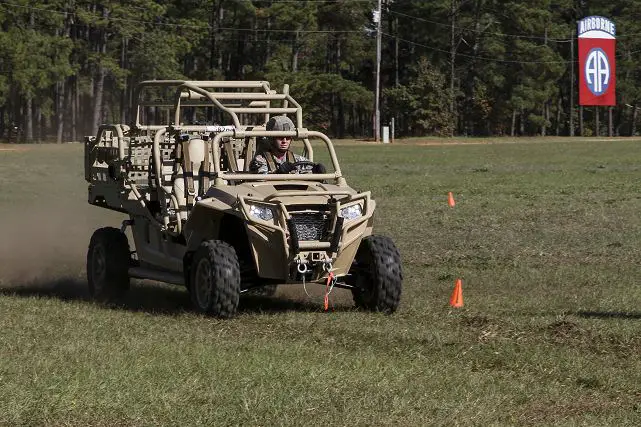United States Airborne Troops begin training with LTATV Light Tactical All Terrain Vehicle 0111144
| a | |||
U.S. Airborne Troops LTATV |
|||
| Saturday, November 1, 2014 02:04 PM | |||
| United States Airborne Troops begin training with LTATV Light Tactical All Terrain Vehicle. | |||
The
2nd Brigade Combat Team, 82nd Airborne Division, currently on rotation
as the ground component of the nation’s Global Response Force, began
fielding and training on new equipment this week. Specifically, Soldier
Plate Carrier Systems, medium rucksacks, and Light Tactical All Terrain
Vehicles will make the quick response force more lighter, more agile and
better tailored to the unique mission requirements of the GRF. |
|||
 A paratrooper assigned to the 1st Battalion, 325th Airborne Infantry Regiment, 2nd Brigade Combat Team, 82nd Airborne Division, drives the Brigade’s new Light Tactical All Terrain Vehicle on Fort Bragg, N.C., Oct. 29, 2014. |
|||
| |
|||
On
call to deploy as part of a battalion-sized task force anywhere in the
world within just 18 hours, the modern paratrooper must pack light, move
quickly and be able to fight and win in any environment and against any
foe. To facilitate, the Army is providing the 2nd BCT with plate carriers
that are lighter and less cumbersome than the traditionally-issued Improved
Outer Tactical Vest, as well as smaller rucksacks for carrying several
days’ worth of sustainment supplies. Bearing the Army’s new
Operational Camouflage Pattern, both pieces of equipment can be jumped
into a combat zone while adding less weight to a paratrooper’s load
than standard issue gear.
However light their equipment, even the strongest and healthiest paratrooper can only move as quickly as their own two legs can carry them. To get paratroopers from the drop zone to the objective more rapidly, the brigade began assessing the Light Tactical All Terrain Vehicle this week. The LTATV is a four-wheel drive, all-terrain vehicle for a crew of up to four, which can also serve as a heavy weapons platform with as many as three mounted M240B machine guns. “The moment we begin to do heavy drops and exit paratroopers, we’re pressed for time to begin building our combat power,” said Capt. Marshall L. Brink, the brigade’s plans officer responsible for coordinating the reception of and training on the LTATV. “A force that may be defending the FLS (Field Landing Strip) gets more time to prepare for the siege of the airfield. If we have the ability to drop more light-weight vehicles that allow our assaulting force to rapidly reach the objective and establish a foothold, that will improve our chances of success tremendously.” With the Army’s fleet of vehicles increasing in size and weight and carrying sensitive electronic technology, the LTATV may answer the question of how to swiftly transport and parachute in as much capability as possible with limited aircraft and minimal space. In addition to providing mobility for maneuver forces, the LTATV can also carry a small amount of supplies and hastily medevac casualties from the battlefield. “Having the LTATV as an asset across a rifle company allows them to do what their normal job would be: just faster and across a greater distance,” said Brink. The 2nd BCT’s 1st Battalion, 325th Airborne Infantry Regiment will be the first battalion to exercise and assess the added capabilities of the new LTATVs by incorporating them into scheduled training events, culminating in the Division’s Joint Operational Access Exercise 15-01 in April next year. |
|||


























